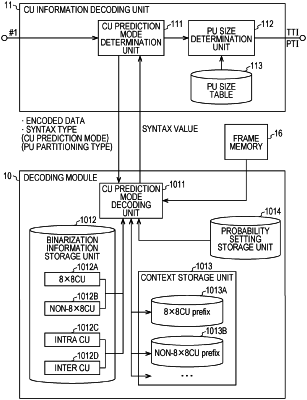| CPC H04N 19/577 (2014.11) [H04N 19/105 (2014.11); H04N 19/119 (2014.11); H04N 19/13 (2014.11); H04N 19/157 (2014.11); H04N 19/159 (2014.11); H04N 19/44 (2014.11); H04N 19/463 (2014.11); H04N 19/52 (2014.11); H04N 19/96 (2014.11)] | 4 Claims |

|
1. An image decoding device for decoding an image in a prediction unit using an inter prediction scheme in which a first reference prediction list and/or a second reference prediction list are used, wherein the first reference prediction list is a list of reference images to be used for inter prediction of a P slice and/or a B slice, and the second reference prediction list is a list of reference images to be used for inter prediction of a B slice, the image decoding device comprising:
motion compensation parameter derivation circuitry that derives a first prediction list utilization flag indicating whether the first reference prediction list is to be used for inter prediction, and a second prediction list utilization flag indicating whether the second reference prediction list is to be used for inter prediction; and
merge candidate derivation circuitry that derives a merge candidate list including a merge candidate, wherein the first prediction list utilization flag, the second prediction list utilization flag, reference indices, and motion vectors are corresponding to the merge candidate, wherein
if (i) a value of the first prediction list utilization flag is equal to a first value, which indicates that the first reference prediction list is to be used for inter prediction, (ii) a value of the second prediction list utilization flag is equal to the first value, which indicates that the second reference prediction list is to be used for inter prediction, and (iii) the prediction unit has a size equal to a predefined value, the motion compensation parameter derivation circuitry converts the value of the second prediction list utilization flag to a second value so that the second reference prediction list is not to be used, wherein the predefined value is a 4×8 or an 8×4, and
the merge candidate list is constructed by using five neighboring blocks neighboring to the prediction unit, wherein (i) a location inside a first neighboring block is set to (xCb+cbWidth−1, yCb−1), wherein (xCb, yCb) is a top left location of the prediction unit and cbWidth specifies a width of the prediction unit, and (ii) the first neighboring block of the five neighboring blocks is stored at a first position in the merge candidate list when the first neighboring block is available.
|